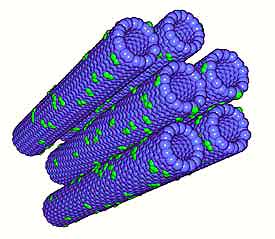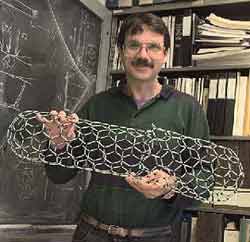| Surprising results from a new study on the
electronic properties of carbon nanotubes -- hollow cylinders of pure
carbon about 50,000 times more narrow than a human hair in diameter --
show that these amazing materials may be even more versatile than anyone
had previously thought.
As part of a broad program investigating the synthesis,
characterization and theoretical modeling of carbon nanotubes, scientists
with the U.S. Department of Energy's Lawrence Berkeley National Laboratory
(Berkeley Lab) and the University of California at Berkeley have reported
that the electronic properties of these tubes are so "extremely
sensitive" to oxygen that exposure to air can convert a
semiconducting nanotube into a metallic conductor.
 |

RECENT EXPERIMENTS HAVE SHOWN THAT SINGLE-WALLED CARBON
NANOTUBES ARE SO SENSITIVE TO OXYGEN THAT THE ADSORPTION OF EVEN A
FEW ATOMS (SHOWN IN GREEN) CAN CHANGE SEMICONDUCTING TUBES INTO
CONDUCTORS.
|
"Many supposedly intrinsic properties measured on nanotubes may be
severely compromised by extrinsic air exposure effects," the
scientists state in a paper published in the March 10 issue of the journal
Science. Some proponents of nanotubes may find this result
discouraging, but not Alex Zettl, a physicist who holds a joint
appointment with Berkeley Lab's Materials Sciences Division (MSD) and UC
Berkeley's Physics Department and is one of the coauthors of the Science
paper.
"This is not a negative finding," he says. "Our results
show that carbon nanotubes are far richer materials than we have
appreciated. We can now envision even more applications in addition to
those already proposed for them. We will need to apply relevant theories
to explain our observations and we may need to reinterpret previous data,
but I see entirely new doors opening for carbon nanotubes."
The other coauthors of this study were Philip Collins, who is now with
IBM's T. J. Watson Research Center in New York, and Keith Bradley and Masa
Ishigami of UC Berkeley.
Says Collins, "We've demonstrated that carbon nanotubes can behave
as both n-type and p-type semiconductors. Until now, all nanotube
measurements had suggested p-type conducting behavior only."
In their paper, the Berkeley researchers found that the degree of
oxygen exposure is the determining factor as to whether a carbon nanotube
functions as an n-type or p-type semiconductor. The ability to function as
either type is critical if nanotubes are to ever replace conventional
silicon devices.
Says Collins, "Junctions between these two types of semiconductors
serve as the electronic building blocks for diodes and transistors.
Without both types, the variety of electronic devices which could be built
from nanotubes would be severely limited."
 |

ALEX ZETTL SHOWN WITH A MODEL OF A CARBON NANOTUBE
|
Zettl suggests that in principle, a nanotube's electronic properties
could be controlled through the use of "protective coatings" to
shield select portions of the nanotube from oxygen exposure. "It
should be relatively simple to keep oxygen on or off specific areas of a
nanotube," he says.
Carbon nanotubes have been highly touted for their potential to succeed
silicon in future electronic devices. Chemically inert and stronger than
steel, nanotubes behave as if they are one-dimensional objects, hence not
subject to the size and heat restrictions that will eventually limit
silicon-based devices. Nanotubes also offer a full range of very useful
intrinsic electrical and thermal conductivity properties.
Prevailing theories have held that the electronic properties of a
nanotube are dictated solely by the diameter and chirality (geometric
configuration) of the tube. Theories also predicted that natural defects
in the hexagonal web of a nanotube's carbon atoms (nanotubes are
essentially tiny sheets of graphite that have been curled and connected
along a seam like a drinking straw) would give rise to the creation of
atomic-sized electronic devices, a prediction that experiments in 1997 by
Zettl and Collins confirmed.
In their latest study, Zettl and his associates found that the chemical
environment surrounding a nanotube is at least as important an influence
on the tube's electronic properties as its diameter. Working with
single-walled carbon nanotubes (SWNTs) grown by conventional laser
ablation methods, the researchers studied both bulk samples and single
isolated tubes. Measurements of both electrical resistance and
thermoelectric power, the voltage induced by a temperature gradient, were
made under environmental conditions that gradually shifted from oxygen to
vacuum and back to oxygen.
"The effects of oxygen exposure became increasingly more
irreversible (and have longer time constants) with decreasing temperature,
as expected for a gas adsorption process," the scientists state in
their Science paper. "In fact, our transport measurements indicate
that, once SWNTs have been exposed to oxygen, it is not possible to fully
deoxygenate them at room temperature even under high vacuum
conditions."
Further evidence that the effects being observed were the result of gas
adsorption came when the topology of the nanotubes was changed. Dilute
SWNT thin films yielded quick electronic changes, while optically thick
films required higher temperatures and longer times to reach equilibrium.
The experiments were repeated with different major gas constituents of
air to confirm that the changes in electronic properties were due to
oxygen adsorption.
Carbon materials such as charcoal are known for their excellent
adsorption and sieving properties, but nanotubes were thought to have been
an exception because of their morphology, especially the smoothness of
their exterior surface. In light of these new findings, the Berkeley
researchers believe that carbon nanotubes could find valuable use as
sensors for oxygen and other gases.
In shifting their exposure environments from oxygen to vacuum and back
to oxygen, the Berkeley researchers found that the TEP voltage sign
switched from positive to negative and back to positive. A positive sign
means the charge carrier is like an electron "hole" which for a
seminconducting nanotube means a p-type semiconductor. A negative sign
means the charge carrier is an electron, which for a semiconducting
nanotube means an n-type semiconductor.
What this suggests, say the Berkeley researchers, is that previous
studies identifying carbon nanotubes as p-type semiconductors were the
result of nanotubes having been "doped" with adsorbed oxygen.
"It is important to keep in mind that all of the electronic
properties which have been reported for nanotubes are still real,"
says Zettl. "The only question is to what extent did those results
depend upon the presence of oxygen. I'm still very excited about the
prospects for nanotubes as electronic devices."
Zettl's group is one of several in the Materials Sciences Division (MSD)
at Berkeley Lab that is studying various aspects of carbon nanotubes.
Other principal investigators in this broad MSD effort include Marvin
Cohen, Steven Louie, Rob Ritchie, Uli Dahmen, and Paul McEuen. In
predicting and demonstrating the synthesis of novel forms of these tubes
and characterizing their highly unusual mechanical and electronic
properties, these investigators have shown that carbon nanotubes could
serve in applications as diverse as exceptionally strong structural fibers
or flat panel displays.
Berkeley Lab is a U.S. Department of Energy national laboratory located
in Berkeley, California. It conducts unclassified scientific research and
is managed by the University of California.
|


